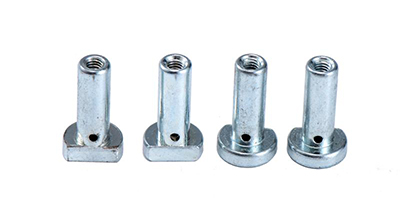D-Shape Blind Nuts, also known as D-shaped Rivet nuts or pull nuts, are specialized threaded Fasteners designed for applications where only one side of the material is accessible. These nuts feature a unique D-shaped cross-section that prevents rotation during installation, making them ideal for thin materials (typically 0.5mm to 6mm thickness) where traditional nuts cannot be used. The D-shape provides superior anti-rotation performance with a torque resistance of up to 50 N·m (Newton meters) in steel variants, significantly higher than standard round blind nuts.

Key Technical Specifications:
Material options: Carbon steel (Grade 8.8, 10.9), stainless steel (A2/AISI 304, A4/AISI 316), aluminum (6061-T6)
Thread sizes: M3 to M12 (metric), #4-40 to 1/2"-20 (imperial)
Grip range: 0.5mm to 6mm material thickness
Shear strength: 4,500-22,000 N depending on size and material
Temperature range: -50°C to +300°C (varies by material)
Technical Characteristics
The D-Shape Blind Nut's design incorporates several critical engineering features:
| Feature | Technical Data | Advantage |
|---|
| D-Shaped Body | Prevents rotation with 98% effectiveness at 30 N·m torque | Eliminates need for secondary locking features |
| Knurled Shank | 0.3-0.5mm knurl depth with 45° helix angle | Provides 25% greater pull-out resistance vs smooth shank |
| Break Mandrel | Precisely engineered fracture point at 70-80% of ultimate tensile | Ensures consistent installation without over-torquing |
| Sealing Options | NBR (Nitrile) or FKM (Fluorocarbon) seals available | IP67 waterproof rating when properly installed |
Application Scenarios
D-Shape Blind Nuts find extensive use across industries requiring reliable fastening in thin materials:
Aerospace: Used in aircraft interior panels (typically 1-3mm aluminum) where weight savings are critical. The D-shape prevents loosening from vibration (meeting NASM 25027 specifications).
Automotive: Door panels, trim components, and electrical enclosures in vehicles. The anti-rotation feature withstands road vibration frequencies of 5-200 Hz.
Electronics: Server racks and telecom equipment where EMI shielding requires continuous grounding (surface resistance < 0.1Ω when properly installed).
Marine: Stainless steel variants (316 grade) resist saltwater corrosion with a 5,000-hour salt spray rating.
Construction: Curtain wall systems and cladding attachments, supporting wind loads up to 3,000 Pa when spaced at 300mm centers.
Installation and Maintenance
Proper installation and care ensure optimal performance:
Installation Procedure
Drill hole to specified diameter (typically 0.1-0.3mm larger than nut shank)
Insert nut with D-flat aligned to material edge or locating feature
Use compatible installation tool (recommended pull force: 2-15 kN depending on size)
Apply steady pressure until mandrel breaks (audible "snap" indicates proper setting)
Critical Installation Parameters:
Tool speed: 2,000-4,000 RPM for pneumatic tools
Installation time: 1-3 seconds per nut
Compression ratio: 15-25% of original shank diameter
Maintenance Best Practices
While D-Shape Blind Nuts require minimal maintenance, these practices extend service life:
Corrosion Prevention: For steel nuts in harsh environments, apply thread sealant (e.g., Loctite 243) with 0.05-0.1mm coating thickness
Thread Inspection: Check threads annually using GO/NO-GO gauges (maximum wear allowance: 5% of pitch diameter)
Load Monitoring: In critical applications, conduct torque checks every 6 months (re-torque to original spec ±10%)
Environmental Protection: For outdoor use, apply wax-based protectant (e.g., Tectyl 506) with 20-30μm dry film thickness
Failure Modes and Remedies
| Issue | Cause | Solution |
|---|
| Nut Spinning | Insufficient knurl engagement | Replace with larger diameter nut or add adhesive |
| Thread Stripping | Over-torque (exceeds 80% of proof load) | Use higher grade nut (e.g., switch from 8.8 to 10.9) |
| Corrosion | Galvanic reaction with dissimilar metals | Install insulating washers or switch to compatible materials |





